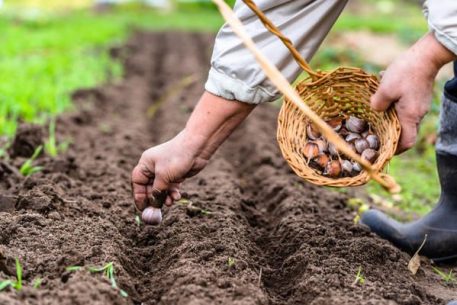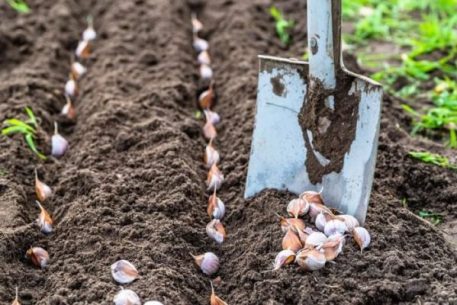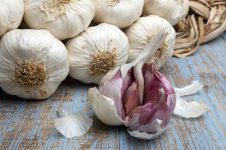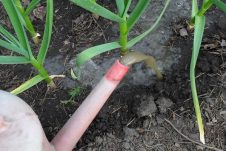Garlic, the cradle of which is Central Asia, is a grassy, perennial joy from the onion genus. A vegetable culture recognized around the world can be cultivated as spring and winter. Before planting garlic in the winter, it is worth learning about all the intricacies of winter sowing of a popular vegetable, which is in demand not only in cooking, but also in the medical field.
Material Content:
Landing and soil preparation
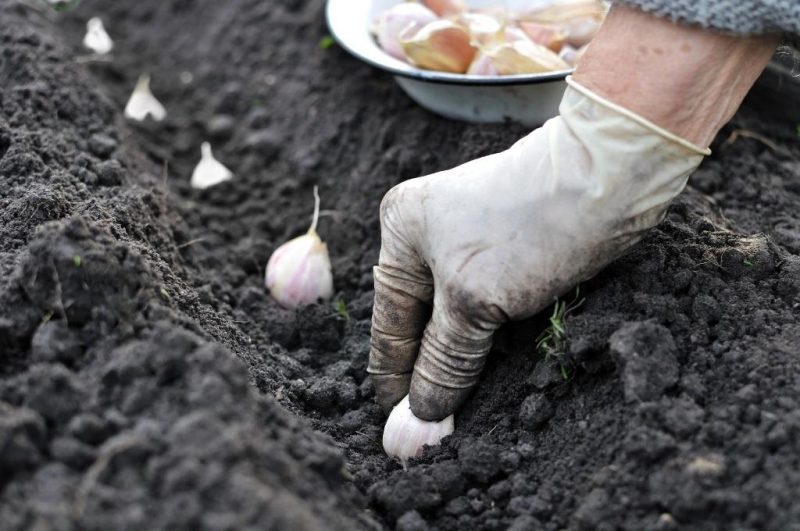
Sowing garlic, which is a light-loving crop, is carried out in sunny areas with loose, fertile soil of non-acidic reaction. Preparing a place for future placement of garlic should be 2-3 weeks. The site is dug up to a depth of 20-30 cm with the simultaneous application of organic and mineral fertilizers at the rate of 5 kg of humus, 30 g of superphosphate, 20 g of potassium salt per 1 m2. Fresh manure, which is the cause of the greater susceptibility of the plant to harmful organisms, should not be introduced. After the land is enriched with nutrients, it should be disinfected - pour with a solution of copper sulfate prepared from 1 teaspoon of a solution diluted in 10 liters of water. For best effect, it is recommended to cover the area with film.
How to determine planting time
To collect a good harvest, it is necessary that the garlic stop the vegetation, having managed to grow the root mass 12 cm long, without developing the aerial part.When these requirements are taken into account, the optimal time is in the second half of September until October 20, depending on the agro-climatic conditions of the cultivation area, since vegetable crops are planted 35-45 days before the onset of frost.
Important! Unrooted winter garlic or green mass will die. In order to avoid freezing of the vegetable, it is necessary to strictly observe the planting dates.
Choosing a variety for planting

One of the components of obtaining a large and high-quality crop is the choice of zoned varieties of winter garlic.
Among the most common and sought after are:
- Lyubasha is a winter and drought tolerant variety bred by Ukrainian breeders. It is represented by heads weighing 70 g, consisting of 7 teeth, as well as the aerial part up to 120 cm high.
- “Ukrainian White” is a non-shooting variety, which can be planted both in spring and autumn. A bulb weighing 140 g has up to 12 cloves.
- "Jubilee Gribovsky" is a high-yielding variety with a bright spicy taste, distinguished by resistance to damage by pests and diseases. High degree of keeping quality.
- "Messidor" is a Dutch variety with excellent yield and large bulbs of 10 cloves.
- "Kharkiv Violet" is a disease resistant variety giving arrows. The name is due to the violet color of flattened bulbs, the weight of which can reach 70 g.
The correct technology and planting pattern of garlic in the winter
In order to collect a rich harvest of a popular vegetable next season, it is necessary to study the nuances of how to plant garlic correctly in the winter.
Then you can plant garlic
Before choosing a territory for cultivating a vegetable, you should decide on the optimal and acceptable predecessors, the placement of winter garlic after which will not reduce the potential indicators of its yield. Suitable previous crops are solanaceous, pumpkin and cereal with a short vegetative phase. If root crops were cultivated on the site, depleting the soil from early spring to mid-autumn, then another place should be found.
At what depth should garlic be planted

The depth of incorporation of garlic will depend on the selected planting material.
For the teeth, grooves with a depth of 15-20 cm are prepared.
If the gardener decided to plant bulbs that give a full bulb only in the second year, then you should not dig out furrows deeper than 3 cm.
How to plant garlic
Landing technology provides for the implementation of a number of mandatory manipulations:
- Planting material is sampled and inspected: injured, decayed and damaged teeth are discarded.
- Healthy teeth are disinfected by keeping in ash liquor for 2 hours.
- Furrows with a distance of 20-25 cm are prepared at the selected site.
- The bottom of the grooves is sprinkled with a layer of coarse sand of 1.5-3 cm, which will protect the teeth from contact with the ground and possible rotting.
- The distance between planting material is maintained at 8-15 cm, which depends on its size.
- After termination, the plants are mulched with a layer of peat or sawdust of 2-3 cm.
- During winters with little snow, the beds are covered with roofing material, which is removed immediately after the start of snowfalls to form a snow cover.
Note! To prepare ash liquor, it is enough to dilute 400 g of ash in 2 liters of cool water, previously boiled for about 30 minutes.
It is interesting:pepper in open field
How to care for winter varieties
Garlic is a cold-resistant crop, which, with proper planting and care in the winter with a developed root system, will not cause much trouble, pleased with an excellent harvest.
Soil treatment
With the advent of spring, plantings are released from the shelter, if it was not removed earlier, and from the layer of mulch, which will allow the sprouts to easily and quickly break through. After the emergence of seedlings, the beds can be mulled again, which will save time on weeding and cultivation, required after irrigation or natural precipitation.
Watering
Winter garlic requires abundant watering during the period of active growth. When the onion formation stage begins, the volumes and frequency of moisture are reduced, which contributes to the continued storage of the crop in the future. In rainy summers, additional irrigation is not necessary.
Fertilizing and fertilizers
When seedlings appear, you should feed the garlic with nitrogen, which it can get from urea, a mullein solution prepared in a 1: 5 ratio with water, or a bird droppings solution with a ratio of 1:10. At the end of June, it is recommended to carry out a second top dressing using 300 g of ash per bucket of water.
Important! When choosing fertilizers, preference should be given to organic matter, to which garlic responds better.
Pruning
At the beginning of summer, the development of arrows is noted, which should be cut off or simply broken out until they reach a height of 10 cm or the formation of a characteristic curl inside. In the absence of such a procedure, the bulb will not have time to develop as it should and will remain quite small.
Disease and Pest Treatment
During rainy summers or overflows on garlic, rust and fusarium can manifest themselves, which should be immediately combated by spraying the beds with a systemic fungicide. Garlic can also be attacked by insects such as onion moth and onion leaf beetle, which can be controlled by an insecticide used according to the manufacturer’s instructions. Observance of crop rotation and pre-planting of cloves will help to prevent the settlement of garlic with even more dangerous pests - a root tick and a stem nematode.
So, the proper planting of winter garlic in compliance with all agrotechnical requirements is the key to a large and high-quality crop.


